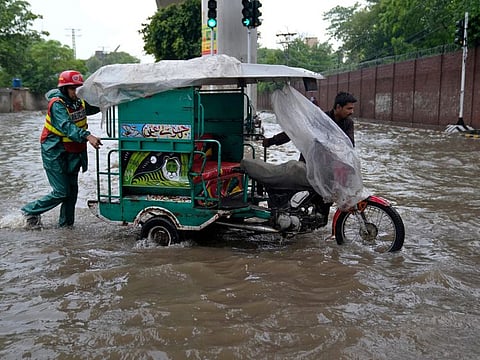Monsoon rain havoc: Pakistan death toll climbs to 68 deaths since June 25
Worst-hit regions include Punjab, where 43 died, Khyber Pakhtunkhwa with 19 fatalities

Islamabad: At least 68 people, including children, have been killed in weather-related incidents since June 25 as Pakistan grappled with heavy monsoon rains, officials say.
The latest situational report issued by the Pakistan National Disaster Management Authority (NDMA) on July 8 reveals that 68 deaths and 127 injuries have been reported since June 25 across the country.
The authority has reported one death, two injuries, and two houses damaged in the past 24 hours due to monsoon rains.
Fatalities and destruction
The cumulative data from June 25 to July 8, reveals that the worst-hit regions include Punjab, where 43 lives have been lost, Khyber Pakhtunkhwa with 19 fatalities, and Balochistan with five reported deaths. Tragic incidents such as electrocution, roof collapses, drowning, and lightning strikes have resulted in these casualties.
The rains have left a trail of destruction, with a total of 79 houses damaged during this period. Balochistan suffered the loss of one house, while KP recorded the highest number of damaged houses at 46, followed by Punjab with 31 properties affected. Fortunately, Sindh and Gilgit-Baltistan have not reported any deaths due to the torrential downpours.
Precautions and forecast
As the monsoon season continues to unleash its fury, the NDMA has urged citizens to stay informed about weather updates and adhere to the instructions provided by local authorities to ensure their safety. Pakistan Meteorological Department (PMD) has issued a significant weather outlook for river catchments in Pakistan from July 9 to 15, warning of potential flash floods and high-level flooding in several areas.
In July 8 advisory, the Met Office alerted residents about the possibility of flash flooding in the hill torrents of Dera Ghazi Khan Division and local Nullahs (streams) of North Balochistan within the next 48 hours. The situation is particularly concerning for River Chenab and the associated streams of Rivers Ravi and Chenab, as high to very high-level flooding is expected in these areas between July 9 and 10. However, the monsoon activity is expected to diminish from July 10.
Guidance for city and district administrations
To mitigate the risks associated with the forecasted impacts, the NDMA has issued crucial guidance to city and district administrations. These include the development of contingency traffic plans in flood-prone areas of cities such as Lahore, Gujranwala, Sialkot, and Faisalabad, to facilitate efficient de-watering operations in flooded underpasses.
Additionally, district administrations are instructed to conduct a thorough assessment of available resources in vulnerable areas and gather on-ground information about these regions to plan an effective response. Marala Headworks on River Chenab and Jassar on River Ravi are specifically mentioned in the instructions. The local administrations have also been urged to spread information to the public regarding emergency preparedness.
Rescue services, as well as leading non-governmental organizations (NGOs), have been called upon to ensure the availability of personnel in the identified areas. The NDMA emphasizes the importance of “proactive coordination among all stakeholders” to enable a prompt and streamlined response at the grassroots level and ensure the safety of the people.
Monsoon forecast for specific regions
As the monsoon season continues, the NDMA has projected further impacts. The forecast indicates a high possibility of severe thunderstorms and heavy rainfall in North and Northeastern Punjab, including cities such as Lahore, Sialkot, and Narowal. Urban areas are particularly susceptible to flooding, while hilly regions face an increased risk of landslides. In Sindh, cities including Karachi, Tharparkar, Sukkur, Larkana, Hyderabad, Badin, and Shaheed Benazirabad are expected to experience thunderstorms and heavy rainfall.
Similarly, Northeastern Balochistan, including areas like Sibbi, Zhob, Kohlu, Qila Saifullah, Khuzdar, Barkhan, Loralai, Dera Bugti, and Lasbela, should prepare for potential thunderstorm activity. Rainfall is also predicted in specific areas of Khyber Pakhtunkhwa, including Bannu, Dera Ismail Khan, Malam Jabba, and Balakot.
Last year, Pakistan witnessed unprecedented rains and floods that killed 1,700 people, affected 33 million people, and submerged one-third of the country under water. The floods also caused $30 billion in losses.
Sign up for the Daily Briefing
Get the latest news and updates straight to your inbox


